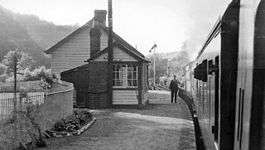Carmarthen and Cardigan Railway
The Carmarthen and Cardigan Railway was a 7 ft (2,134 mm) broad gauge railway from Carmarthen, Carmarthenshire, to Newcastle Emlyn, Wales. Part of the route is now used by the Teifi Valley Railway and the Gwili Railway.
Despite the name, the line never reached Cardigan. Instead, that was achieved by the Whitland & Cardigan Railway which took a more westerly route and became a branch of the Great Western Railway,
Line History
The line was authorised in 1854 as the Carmarthen and Cardigan Railway's abortive attempt to create a rail link from Carmarthen to Cardigan. By 1860 the Company manage to construct the line as far as Conwil before having to cease further works until it could raise enough capital to build the line to Pencader in 1864. The line was extended to Llandysul railway station a few months later but by that time the Company was in severe financial difficulties and went into receivership. In 1867 attempts to run the line were made with horse-drawn buses covering the uncompleted sections but in 1881 the Company was wound up. The line was then bought by the Great Western Railway (GWR) who completed the line up to Newcastle Emlyn in 1895. A quiet line that primarily served the local market and tourism, it was transferred to British Rail at nationalisation[1] The line closed to passengers in 1952[2] and completely in 1973.[3]
Stations

| Carmarthen-Aberystwyth Line | |||||||||||||||||||||||||||||||||||||||||||||||||||||||||||||||||||||||||||||||||||||||||||||||||||||||||||||||||||||||||||||||||||||||||||||||||||||||||||||||||||||||||||||||||||||||||||||||||||||||||||||||||||||||||||
|---|---|---|---|---|---|---|---|---|---|---|---|---|---|---|---|---|---|---|---|---|---|---|---|---|---|---|---|---|---|---|---|---|---|---|---|---|---|---|---|---|---|---|---|---|---|---|---|---|---|---|---|---|---|---|---|---|---|---|---|---|---|---|---|---|---|---|---|---|---|---|---|---|---|---|---|---|---|---|---|---|---|---|---|---|---|---|---|---|---|---|---|---|---|---|---|---|---|---|---|---|---|---|---|---|---|---|---|---|---|---|---|---|---|---|---|---|---|---|---|---|---|---|---|---|---|---|---|---|---|---|---|---|---|---|---|---|---|---|---|---|---|---|---|---|---|---|---|---|---|---|---|---|---|---|---|---|---|---|---|---|---|---|---|---|---|---|---|---|---|---|---|---|---|---|---|---|---|---|---|---|---|---|---|---|---|---|---|---|---|---|---|---|---|---|---|---|---|---|---|---|---|---|---|---|---|---|---|---|---|---|---|---|---|---|---|---|---|---|---|
Legend | |||||||||||||||||||||||||||||||||||||||||||||||||||||||||||||||||||||||||||||||||||||||||||||||||||||||||||||||||||||||||||||||||||||||||||||||||||||||||||||||||||||||||||||||||||||||||||||||||||||||||||||||||||||||||||
| |||||||||||||||||||||||||||||||||||||||||||||||||||||||||||||||||||||||||||||||||||||||||||||||||||||||||||||||||||||||||||||||||||||||||||||||||||||||||||||||||||||||||||||||||||||||||||||||||||||||||||||||||||||||||||
In order, north to south:
- Newcastle Emlyn
- Henllan
- Allt-y-cefn tunnel
- Pentrecourt halt opened 1912
- Llandysul
- Pencader Junction- closed 1880
- Pencader
- Llanpumsaint
- Conwil
- Llwyfan Cerrig opened in 1988 by Gwili Railway
- Bronwydd Arms
- Abergwili Junction - junction with Llandeilo and Carmarthen
- Carmarthen Town- closed 1902
- Carmarthen – junction with South Wales Railway, still open.
Broad gauge locomotives
Sharp, Stewart 4-4-0Ts
| |||||||||||||||
| |||||||||||||||
- Heron (1861–1872)
- Magpie (1861–1872)
The first two locomotives for the Carmarthen and Cardigan Railway were 4-4-0 locomotives with straight side tanks, built by Sharp Stewart and Company in 1861.
After the line was converted to standard gauge in 1872, they were sold to the South Devon Railway and Cornwall Railway respectively, although the locomotives for both these railways were worked as a common pool. They were both rebuilt with saddle tanks.
In 1876, they became the property of the Great Western Railway and carried the numbers 2134 and 2135. Magpie was withdrawn in 1889 but Heron lasted until the gauge conversion. It worked the last broad gauge train from Tavistock to Plymouth Millbay railway station on 20 May 1892 before pulling the empty carriages to Swindon railway works for dismantling.
The locomotives were named after birds. See Heron and Magpie.
Rothwell 4-4-0STs
.jpg)
| |||||||||||||||
| |||||||||||||||
- Etna (1864–1868)
- Hecla (1864–1872)
Two more locomotives were built by Rothwell and Company in 1864, this time with saddle tanks rather than side tanks.
Etna was sold to the South Devon Railway in 1868, and Hecla followed when the gauge was converted in 1872. They received the numbers 2132 and 2133; at some time Etna received a new saddle tank and its name was lost. They both survived until the end of the broad gauge in 1892.
The locomotives were named after volcanoes. See Mount Etna and Hekla.
Standard gauge locomotives
Four standard gauge locomotives were operated by the Carmarthen and Cardigan Railway, three of them secondhand from the Great Western Railway.
See also
References
- ↑ Atterbury, P (2006) Branch Line Britain: A Nostalgic Journey Celebrating a Golden Age, David & Charles, Newton Abbot P164
- ↑ Disused Stations: Newcastle Emlyn Station
- ↑ http://www.teifivalleyrailway.com/4.html
- The Locomotives of the Great Western Railway, Part 2: Broad Gauge. The Railway Correspondence and Travel Society. ISBN 0-901115-32-0.
- MacDermot, E T (1931). History of the Great Western Railway, volume II 1863-1921. London: Great Western Railway.
- Sheppard, Geof (2002). "The Last Broad Gauge Train". Broadsheet (Broad Gauge Society) 47: 26–34.
- Waters, Laurence (1999). The Great Western Broad Gauge. Hersham: Ian Allan Publishing. ISBN 0-7110-2634-3.
External links
- Carmarthen and Cardigan Railway at railscot.co.uk
- Newcastle Emlyn station and line history
- Teifi Valley Narrow Gauge Railway line history